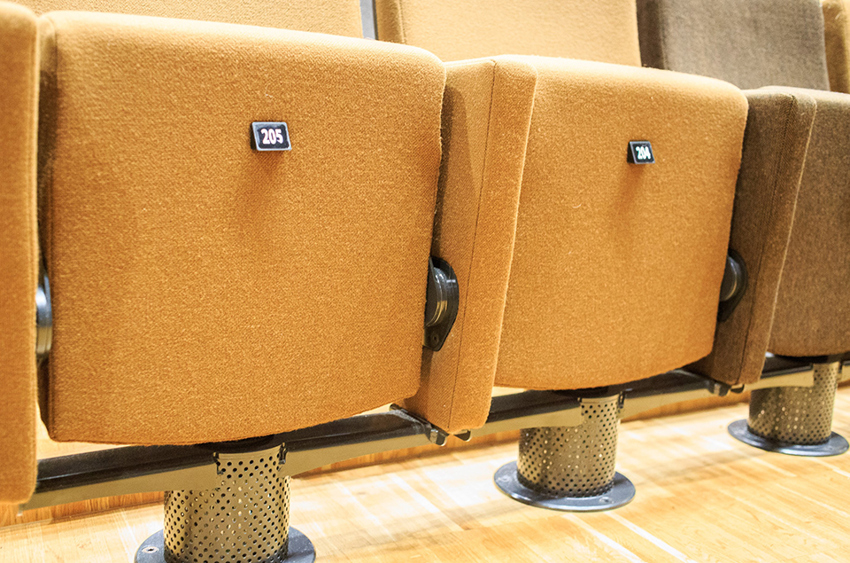Concert halls as an example for large air flows and limiting of noise
Many different building applications require large air flows and close to all buildings have to address sound in some way. This section in our public buildings guide uses concert halls to highlight the most important aspects of these indoor climate factors. Consider our shared knowledge as food for thought in your coming project, no matter if it is a concert hall or not.
How to ventilate when it is show time?
Focusing on the concert hall and on what happens close to show-time, the matter of ventilation becomes cruicial. A concert hall usually faces a rapid increase in occupancy which means that the building needs air handling units of accurate capacity and with boost functionalities. The latter ensures a vast increase in air flow when the concert hall starts to crowd up.
Normally, concert halls and the like require supply air of about 15-18 degrees Celsius. To minimise the need to either heat or chill the supply air, it is highly recommended to select air handlers with efficient energy exchangers which make use of the heat or cold in the exhaust air and transfer it to the supply air. In addition, a sorption treated exchanger can also handle moisture, and thereby further minimise the heating or cooling capacity. Selected air handling units should also be complemented by an additional chiller, as there will be a primary need to reduce the temperature in the premises.
Blog: How does a chiller work?
Learn more about energy recovery in our guide

For the audience to be comfortable and thrive
Draught
Important to consider in regards to concert halls, is the risk of causing draught and noise when large air flows are needed to ensure good air quality. It is not only the sound from the instruments that is sensitive to draught, so is also the audience. In a concert hall, it is fairly safe to say that the audience is seated during most of a performance. That means a higher risk that draughts cause chilling effects and thermal comfort issues.
To avoid problems with draught, it is key to carefully select air terminals suitable for the premises, active or passive, perhaps with additional Coanda wings, and place them wisely in the indoor space. Note that multiple diffusers and beams allow for adjustments of the distribution pattern which makes it easier to avoid uncomfortable draughts. Last but definetely not least, it is highly recommended to consider a solution for variable air volumes (VAV) or demand controlled ventilation (DCV) which, by the means of sensors, can adjust the indoor climate to the actual need.
Learn more about DCV in our technical guide
Here is more about air velocity and draughtSOUND
Sound is an incredibly extensive notion, not only because there are sounds everywhere around us, but because there are many different sounds - audible and inaudible, beautiful and absolutely horrible. Our technical guide dives deep into sound and acoustics, while we in this context settle with making recommendations of how to ensure that the beautiful sound is heard, and the unwanted noise is eliminated.
The tips for how to create a positive sound experience depends on the purpose of the room or the building, but it is a fact, that when the obvious unwanted noise is eliminated, other sounds appear clearer. The remaining sound is perceived strengthened and some of these sounds can then turn out to be disturbing as well. Knowing this, it is highly important to not only eliminate the apparent noise from an HVAC solution, but also to monitor the sound level of the entire solution for ventilation, heating and air conditioning to not induce unwanted noise.
More about sound in our indoor climate guide
NOISE attenuation - plant and duct
When noise is considered in relation to an HVAC solution, there are three stages to be aware of. Sound from mashinery, sound in ducts and sound in room.
Sound from mashinery can either be generated from the actual running of a unit or it can be sound from a unit's vibrations. The latter is sound that can propagate in the building structure and create monotonous noise. To eliminate unwated sound, low noise versions of units may be selected and the physical installation is important to limit vibrations. Inaudible noise might sound as a negligible matter, but is in reallity very harmful and critical to exclude from the soundscape. Learn more in our blog section.
To eliminate sounds in the duct work, the use of sound attenuators is the most efficient measure. These products from Swegon use porous mineral wool as the absorbing materia, and part of the sound energy is converted, by friction, into barely noticable heat.
To our acousitics blog section, all about sound and noise
Find out more
noise attenuation - room
There are a few things to think about inside a concert hall. First of all a decision should be made between mixing ventilation and thermally controlled ventilation. The latter can be suitable if utilised as in the case of Malmö Live, further reading suggested below, but if the thermally controlled ventilation is placed on the perimeter of the concert hall, there is a risk of both draught and noise for the people sitting closest to the diffusers.
Mixing ventilation can be difficult as the ceiling height normally is great in concert halls. However, the audience is not very active which means that the cold air easily can fall down to the occupancy zone and allow for a comfortable indoor climate. With mixing ventilation, the supply air is introduced far above the audience heads which prevents chilling effects and noise issues further down in the premises.
Worth to consider, is the fact that textiles work very well to counteract noise. Furniture as well as floors can be clad and curtains along bare walls can give both a comfy feeling and prevent unwanted reflective sounds.
More in the reference case of Malmö Live
To our guide about ventilation principlesA concert hall is also an office
A concert hall is a sparsely populated building in between concerts. Some people work in the premises and musicians might come and go for practises, but in comarison to what happens when it is show-time, and a performance is about to begin, a concert hall is a fairlly quiet building.
As said earlier in this guide, people working here need a productive indoor climate, and that is not created by using the same design for ventilation, heating and air conditioning (HVAC) as for the larger indoor space in a concert hall. Offices, conference rooms and other premises should consider the recommendations and tips given in our office and/or hotel guides.
Products
A selection of products as alternatives for a concert hall where large air flows and sound elimination is of greatest importance



